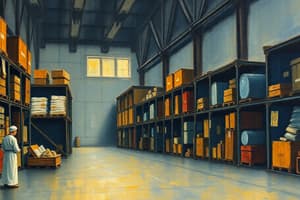Podcast
Questions and Answers
What is a characteristic of the unorganized sector in product recovery?
What is a characteristic of the unorganized sector in product recovery?
Few formal contracts due to its immature state and high volatility.
Why is it time-consuming and costly to obtain design details and evaluate products in product recovery?
Why is it time-consuming and costly to obtain design details and evaluate products in product recovery?
Due to the low value of returned products.
What is a challenge in product recovery due to its supply-driven nature?
What is a challenge in product recovery due to its supply-driven nature?
Unpredictable returns from consumers, making it hard to control the process.
Why are manual processes in product recovery slow, costly, and prone to errors?
Why are manual processes in product recovery slow, costly, and prone to errors?
Why do time-sensitive items like clothing and electronics have low margins?
Why do time-sensitive items like clothing and electronics have low margins?
What drives recycling in the electronics sector?
What drives recycling in the electronics sector?
What is a challenge in recycling appliances like refrigerators and washing machines?
What is a challenge in recycling appliances like refrigerators and washing machines?
What is the advantage of designing products for disassembly?
What is the advantage of designing products for disassembly?
Why is the automotive sector's recycling process advanced?
Why is the automotive sector's recycling process advanced?
What can the appliance recycling industry learn from automotive recycling practices?
What can the appliance recycling industry learn from automotive recycling practices?
Flashcards are hidden until you start studying
Study Notes
Supply Chain Management
- Customer demand is customized to a high degree, taking a long time to achieve, and examples include special orders, customized tools, and restaurant orders.
Types of Supply Chain Management
- Product supply starts before the customer enters a supermarket, involving daily commodities like milk, bread, and rice.
5 Steps in Supply Chain Management
- Plan: Finding the balance between supply and demand, and thinking about what to produce.
- Source: Identifying suppliers that meet expectations.
- Make: Manufacturing the product.
- Deliver: Sending the final product to customers, including warehousing and management.
- Return: Receiving returns associated with the product.
Supply Chain Architecture
- Short: Supplier -> Company -> Customer
- Broad: Supplier's supplier -> Supplier -> Company -> Customer -> Customer's Customer
Types of Customers
- Distributor: Buys from the manufacturer in large bulks and sells to customers, example: tank stations, airports.
- Wholesaler: Buys from distributor or manufacturer, specializing in a specific category, example: catering, hotels, and restaurants.
- Retailer: Stocks quantities in a smaller amount, selling to general customers.
Firms that Provide in Supply Chain
- Transportation
- Technology
- New design
- Warehousing
- Market research
- Sustainability
- Finance
Supply Chain Dynamics
- Supply chain reacts to external environmental and macroeconomic factors.
Placing and Handling Orders
- Order management: Placing orders with a good working system to handle large orders.
- Progress and delivery: Company monitors and splits into two teams: logistics and buying.
- Payment and review: Pays suppliers and reviews service quality.
Strategic Sourcing Initiatives
- Tactical sourcing: Efficient sourcing to achieve benefits and profits.
- Market research: Researching market trends for a specific item.
- Commodity analysis: Analyzing commodity products to save costs.
- Forecast requirements: Predicting future prices to get better deals.
- Supplier performance analysis and benchmarking: Evaluating supplier performance.
- Price and cost analysis: Comparing prices to get the best item.
Category Sourcing or Management
- Category management: Dividing products into categories, each with a dedicated team to manage purchasing and inventory.
- Category profiling: Determining supplier influence and market power.
- Segmenting category groups: Identifying routine, bottleneck, leverage, and critical items.
5 Steps in Category Sourcing
- Profile category group: Determining supplier influence and market power.
- Selecting sourcing strategies: Deciding on the best approach based on category importance and risk.
- Generating a supplier portfolio: Creating a list of potential suppliers.
- Following the purchasing process: Doing pre-order and post-order steps.
- Negotiation: Finalizing agreements with suppliers.
Supply Relationship Management
- Benefits: Breaking down functional barriers, promoting innovation, improving supply chain visibility, sharing assets, and forward thinking.
Manufacturing Strategies
- Just-In-Time concept: Producing only what is needed, when needed, to reduce inventory and waste.
Elements of Just-In-Time
- People: Informed at an early stage, with support and agreement.
- Plant: Driven by customer demand, producing only necessary items, and focusing on worker flexibility.
- System: Refers to technology and process used to connect, plan, and coordinate manufacturing activities.
Limitations of Just-In-Time
- Cultural difference: Difficulty adapting to cultural differences in regions/countries.
- Loss of safety stock: Risk of running out of stock due to producing only what is needed.
- Decreased individual autonomy: Employees need to stick to a strict management of manufacturing.
Unorganized Sector
- Characteristics: Less organized, few formal contracts, high volatility, and immature state.
- Challenges: Lack of information and skills, supply-driven nature, manual processes, and low margins.
Return Differences in Each Process
- Automotive: Advanced recycling processes due to high value of materials like steel and aluminum.
- Electronics: Challenging to make a profit due to high labor costs and lack of automation.
- Appliances: Unpredictable returns due to long lifespans, with recycling processes similar to vehicles.
Activities to Increase Business Return Efficiency
- Design for Disassembly: Prioritizing designs that allow for easy disassembly, facilitating reuse, recycling, or scrapping.
Studying That Suits You
Use AI to generate personalized quizzes and flashcards to suit your learning preferences.




